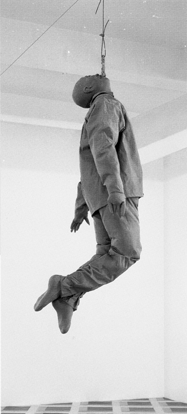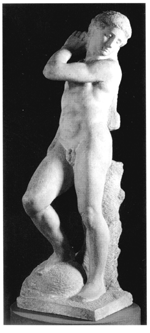

 1.
1.
With the rise of conceptualism, facial representation seemed to whither back into the confines of art history. Sure, the face of Mao may stare from the “contemporary” section of the Art Institute of Chicago, but this critic would be hard pressed to consider the massive Technicolor head anything more than a Warholian ruse.
From Dadaism, Minimalism, and the works, on to our ever-trendy Young British Artists (with a few exceptions), we see that the face exists only within a symbolic void in contemporary art. Whatever happened to the sneer, the leer, and the ecstatic grin that captivates the spectator in a kind of external exchange? Well, from what I’ve found, it’s most likely upstairs.
The Juan Muñoz exhibit at the Art Institute faces the very issue of contemporary art through simple paradox: conversation. How now brown cow? Can it honestly be that elementary? Set aside your Dick and Jane, my dear friends, because this sculptor offers you a chair in the sitting room of casual banter. Right, so Muñoz’s ventriloquist dummies and rather awkwardly formed human clones aren’t your usual companions for an intriguing chat. No matter, they will continue talking whether you join in or not, and if you aren’t careful, the conversation will most certainly be about you.
Take “Five Seated Figures,” for instance. The small grouping glows gold with some precious energy, each on his respective throne, each deeply engaged in the topic at hand. Curious about this intriguing topic, you begin to greedily query their faces for answer. Finally, the last face points you toward the angled mirror at its back. Of course, there is nothing to see but yourself, carefully configured amongst the golden bodies. The entire exchange has been scripted (your expression serves as dialogue enough) and you filter your way back through the chairs, slightly embarrassed at having been the object of the joke.
Towards the corner, in the back of the exhibit space, is a grouping of seven gray resin bodies all the same but with different stances, each face contorted into a singular expression. Of course it is a sublimation of the gaze; of course it is a theater of spectatorship. More than that though, this art party is a marvel in its own strange self-satisfaction. In such pieces, our austere museum gets a slight pinch in the butt, something to give it the verve necessary to reconcile its holier-than-thou French pomposity with nice toothy grins and two men rolling around on a shoebox train (see “Living in a Shoebox”).
So, you ask, what does it matter that Muñoz clones men in “Many Times,” or even builds mysterious banisters and balconies, if it is only to trip us up? Well, I would have to say that art, like a magic trick, should be useless if it is meant to have any meaning at all. If we were to make some sort of “conceptual” statement, we could say Muñoz was a true anti-proletarian, but really, his faces are just men on their day off, flirting with our curiosity. After re-visiting the exhibition a number of times we are better not for having seen it, but for actually having been a part of the piece. By turning our face towards the piece, we recognize our own place in the history of revelry.

2.
My recent visit to the Art Institute exhibit The Medici: Michelangelo and the Art of Late Renaissance Florence connected me temporarily to a formal, old-world mentality. One of the greatest virtues of being an artist is honing the ability to step outside the norms, especially your own, in order to really see, and, ultimately, to create. The exhibit contained thematically figural works from Renaissance artists. For example, “Copper-Color” court painter Angolo Brozino primarily painted the portraits of the Medici offspring.
Standing in front of so many Mannerist style portraits gave me the opportunity to attempt to recognize their formality. However, I was immediately bored with the conceptual idea of these aloof, intelligent, self-contained, and obviously self-assured characters. My anatomical journey was, visually, much more exciting and educational, because as “paintings” the portraits referenced form as content. The same factor remained for the statues that consistently reflected on the classical practice of heroic nudity. However, these massive creatures were full of endless, directional, and figural narratives. The hands were especially full of individually addressed passages right down to the fingernail. They seemed to have multifaceted visual languages that could stand alone, yet at the same time the hands flowed in complete harmony with the rest of the figure.
The roaring, gestural symphonies of the drawings were undeniably the powerhouse of the exhibit. They were conceptual revolutions orchestrated with honesty and confidence and were endlessly subjective. One in particular was Michelangelo Buona-rroti’s, red chalk drawing “Lament-ation over the Dead Christ.” On the one hand it could be interpreted as a religious allegory, while on the other it read like erotica.
Just as soon as I felt trapped inside the solidness of these paintings and sculptures, I discovered that the media often protested their newfound outlet. The aesthetically pleasing patina on some bronze sculptures could also be noted as bad corrosion on others. Patina, the film on bronze that develops over time due to oxidation, is exquisite in Benvenuto Cellini’s “Head of Medusa.” It also psychologically probes the sculptural narrative of this undeclared surrealist piece.
The color and glazing of paintings obligate any painter or color theorist to use these historic advances as reference for their own heuristic investigations. The color sensitivity was particularly expressed through the whites. Massive amounts of power in the subdued muddied, and whitest whites poured out of the paintings. While other color decisions, like the overpowering cobalt blue in Jocopo Zucchi’s “Age of Gold: Allegory of The Creation,” had me wondering: why?
As an entire exhibit, the curatorial approaches were directed towards the viewer’s ability to interact with the work and clearly read each piece multilaterally. And from a feminist point of view, the placement of Cristofano Allori’s “Judith with the Head of Holfernes” on a ninety degree angle from Jacopo Ligozzi’s, “The Rape of the Sabine Women,” soothes like honey for any raw and soar throats. The Medici: Michelangelo and the Art of the Late Renaissance Florence is exhibiting through Feb. 2.
All images courtesty of the Art Institute of Chicago